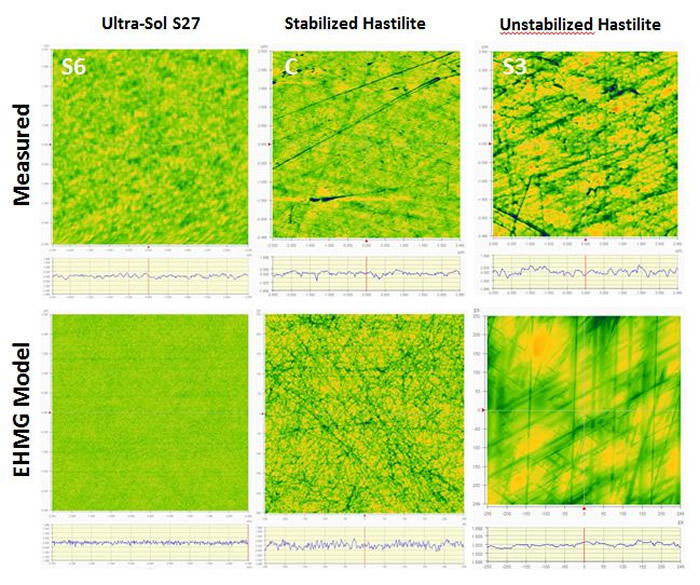Science & Technology - 2016
September
Developing New Tools for Smoothing Glass Optics
Polishing the surface of an optic for a high-energy laser system like NIF has a lot in common with sanding a wooden table. Coarse sandpaper (abrasive slurries and polishing pads for optics) removes surface imperfections relatively quickly and easily. Fine sandpaper provides a smoother finish, but requires more time or more effort—more pressure—to complete the job.
In the case of optics, effective polishing also requires an understanding of the complex physics and chemistry involved in optical finishing. As part of a decades-long drive to improve the quality and damage resistance of glass optics, LLNL researchers are studying the microscopic interactions that occur during polishing and post-chemical treatments of optics and are using their findings to develop new techniques for cost-effectively reducing the roughness of optical glass surfaces. Along with enabling higher fluence and higher power operation of high-energy laser systems, optics with improved surfaces also could provide greater flexibility in designing future lasers.
 Comparison of measured (top) and simulated (bottom) surface roughness (5×5 microns) of fused silica polished using slurries with different particle-size distributions. The simulations used the LLNL-developed Ensemble Hertzian Multigap (EHMG) model, which simulates trends in observed roughness over a variety of polished surfaces.
Comparison of measured (top) and simulated (bottom) surface roughness (5×5 microns) of fused silica polished using slurries with different particle-size distributions. The simulations used the LLNL-developed Ensemble Hertzian Multigap (EHMG) model, which simulates trends in observed roughness over a variety of polished surfaces. The work, funded by LLNL’s Laboratory Directed Research and Development (LDRD) program, aims to “increase scientific understanding of the microscopic and molecular interactions that occur during polishing and post-processing, and how they influence the roughness of glass surfaces,” said Tayyab Suratwala, program director for optics and materials science and technology. “This new knowledge will allow us to develop cost-effective methods to achieve very low roughness on optical glass surfaces.” The research team’s goal is to reduce the size of surface defects to one-tenth of a nanometer—near-atomic-level smoothness.
The researchers have created a new polishing model, the Ensemble Hertzian Multigap (EHMG) model, to determine how polished surface roughness is influenced by the size of the slurry particles and the surface characteristics of the polishing pad. They also have developed a new diamond-conditioning treatment for polishing pads that reduces roughness and reduces polishing time while significantly increasing the lifetime of the pad.
In addition, by measuring the chemical and mechanical surface properties of different polished glasses, the researchers have achieved a more detailed understanding of the formation of the Beilby layer—a defect layer about seven-tenths of a nanometer deep that forms on an optic’s surface during polishing and can lower the optic’s damage resistance.
The energy of high-peak-power laser systems can be limited by the material quality—often the surface quality—of their glass optics. During fabrication, post-processing, and laser operation, many complex surface interactions occur that can create, modify, or remove surface damage precursors such as microfractures (scratches), chemical impurities, and particulate contamination. These factors can scatter the laser light and cause localized laser damage via direct absorption and heating or downstream modulation of the incoming light.
Two process technologies used for NIF—an economical single-step polishing method called Convergent Polishing and a novel buffered oxide etch process called the Advanced Mitigation Process—will or have substantially increased the cost-effectiveness and laser damage resistance of fused silica optics (see “Keeping NIF Optics on the Job”). Combining these more damage-resistant optics with NIF’s “Loop” strategy for recycling damaged optics has helped NIF fire more than 400 shots in the current fiscal year (see “NIF Tops 400 Shots in Fiscal Year 2016”).
The advances made by the LLNL team’s work on roughness are leading to improvements in the Convergent Polishing process in terms of lower roughness and reduced process times.Joining Suratwala for the optics smoothing research are Rusty Steele, Rebecca Dylla-Spears, Nan Shen, Mike Feit, Lana Wong, Richard Desjardin, Phil Miller, Selim Elhadj, and Tom Lee. For more information, see “Optics Become Less Rough, More Tough,” Science & Technology Review, July/August 2016.
 LLNL chemist Rusty Steele operates the convergent, initial-surface-independent, single-iteration, rogue-particle-free surface polishing (CISR) polisher that uses the Convergent Polishing technology. The instrument, which can finish flat and spherical glass optics in a single iteration regardless of the workpieces’ initial shape, won a 2014 R&D100 Award.
LLNL chemist Rusty Steele operates the convergent, initial-surface-independent, single-iteration, rogue-particle-free surface polishing (CISR) polisher that uses the Convergent Polishing technology. The instrument, which can finish flat and spherical glass optics in a single iteration regardless of the workpieces’ initial shape, won a 2014 R&D100 Award. 


